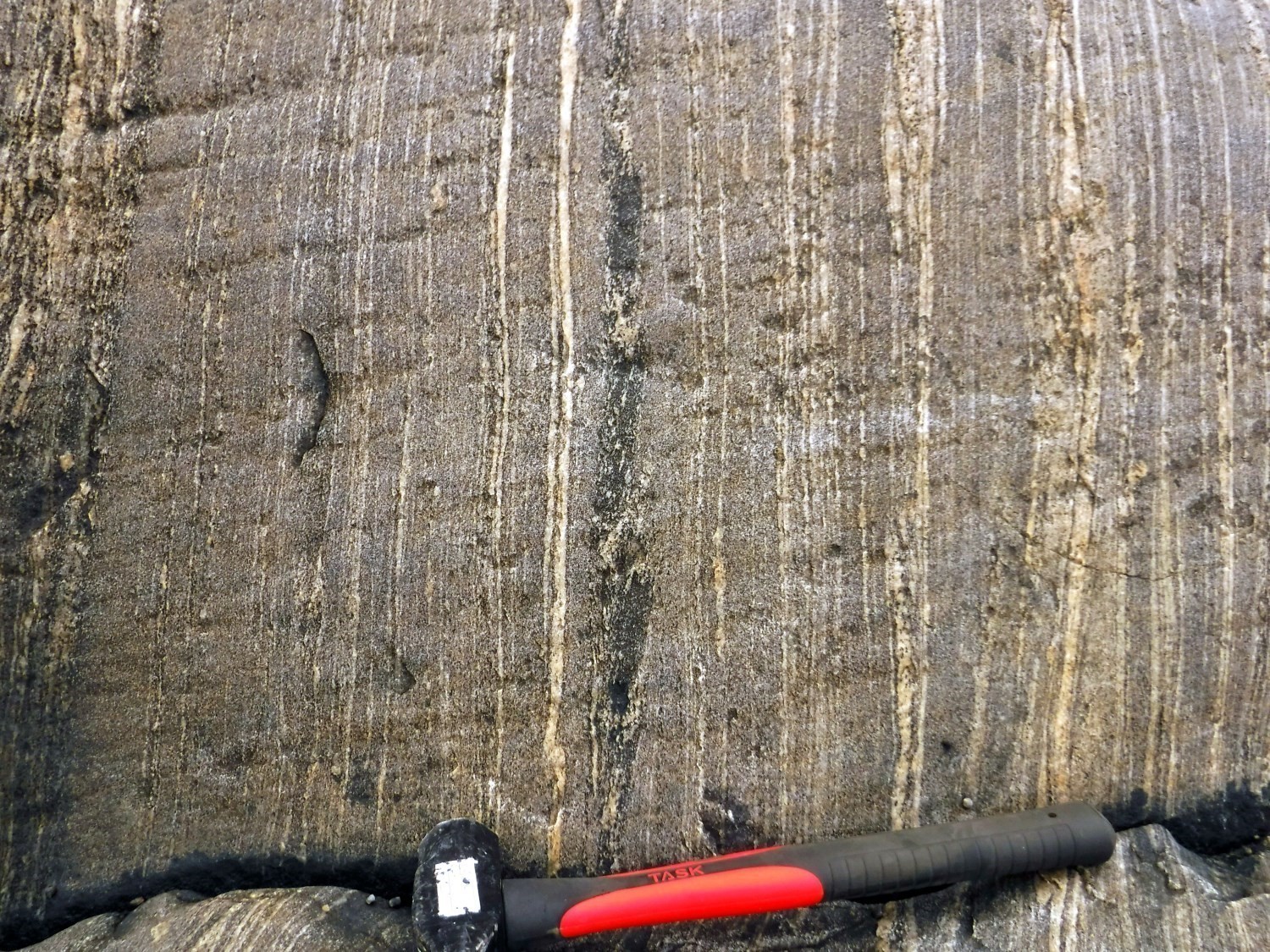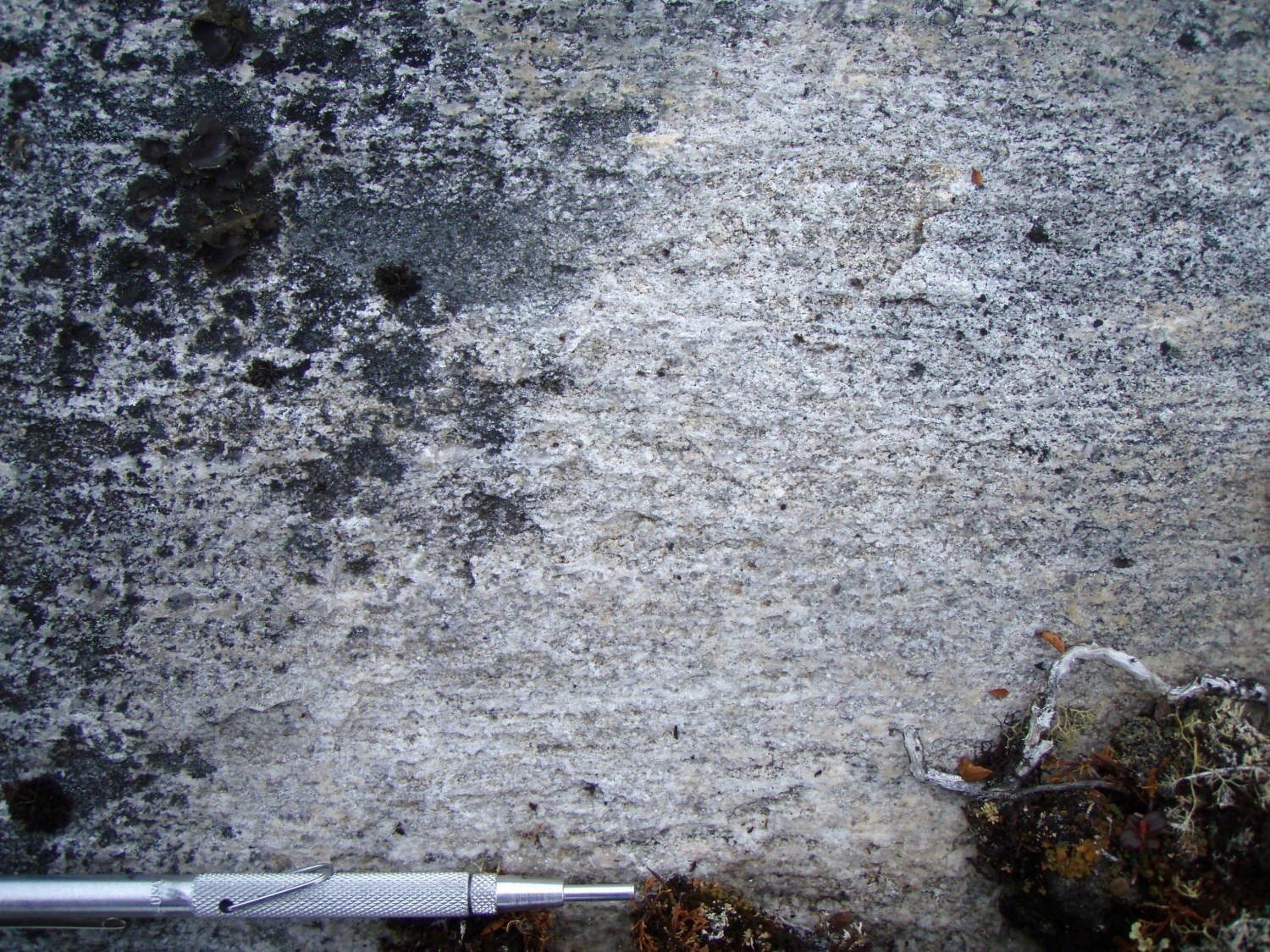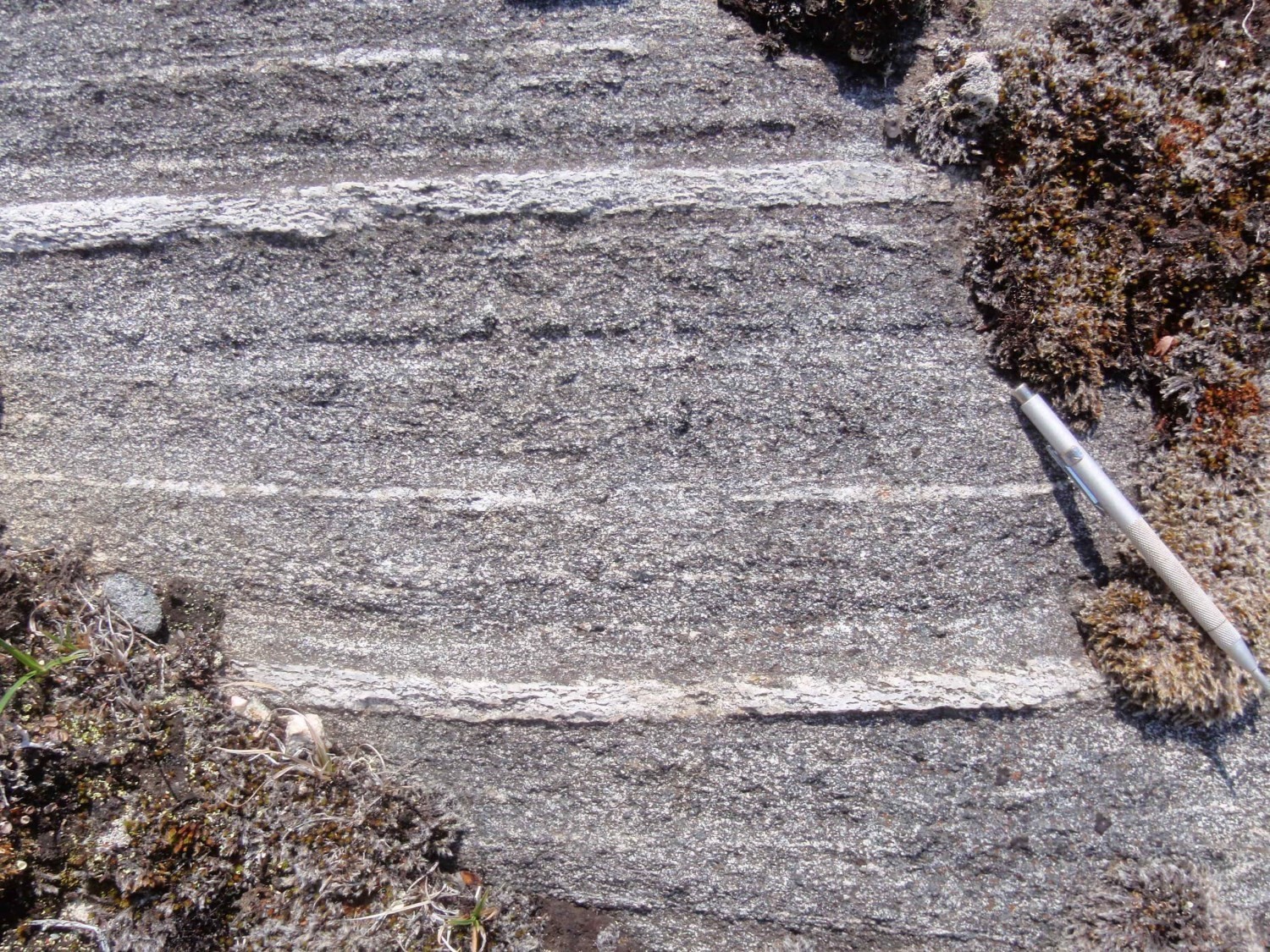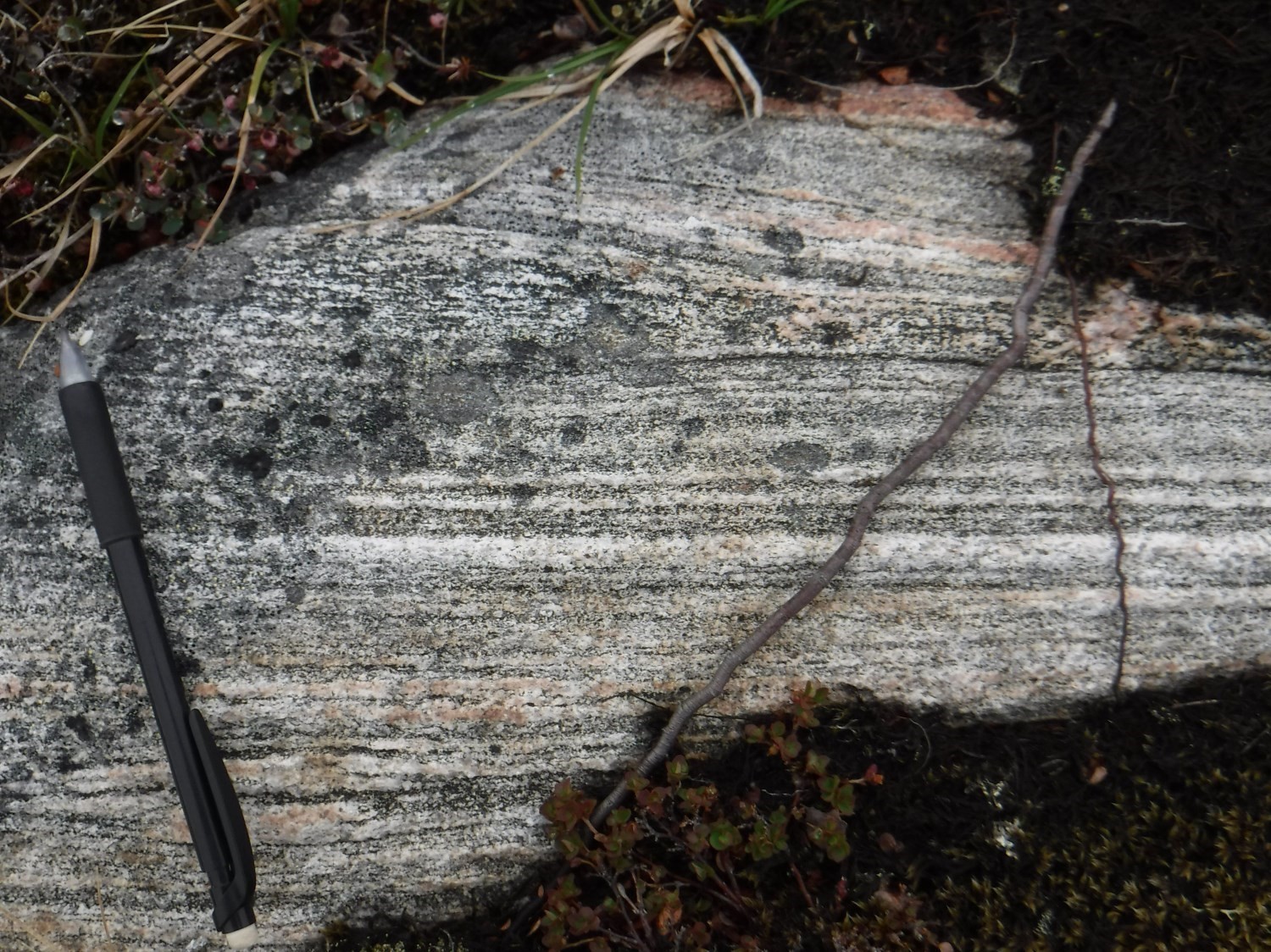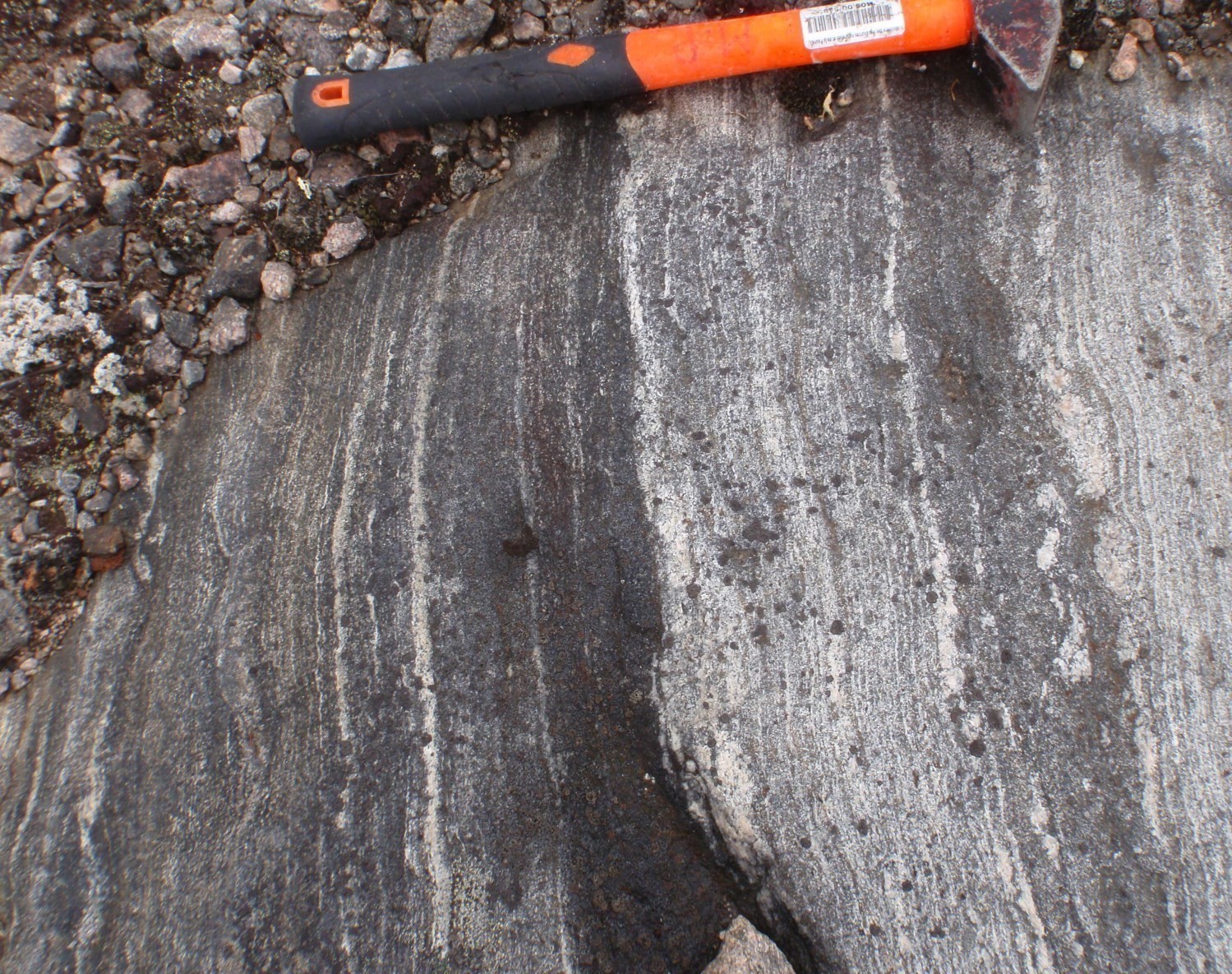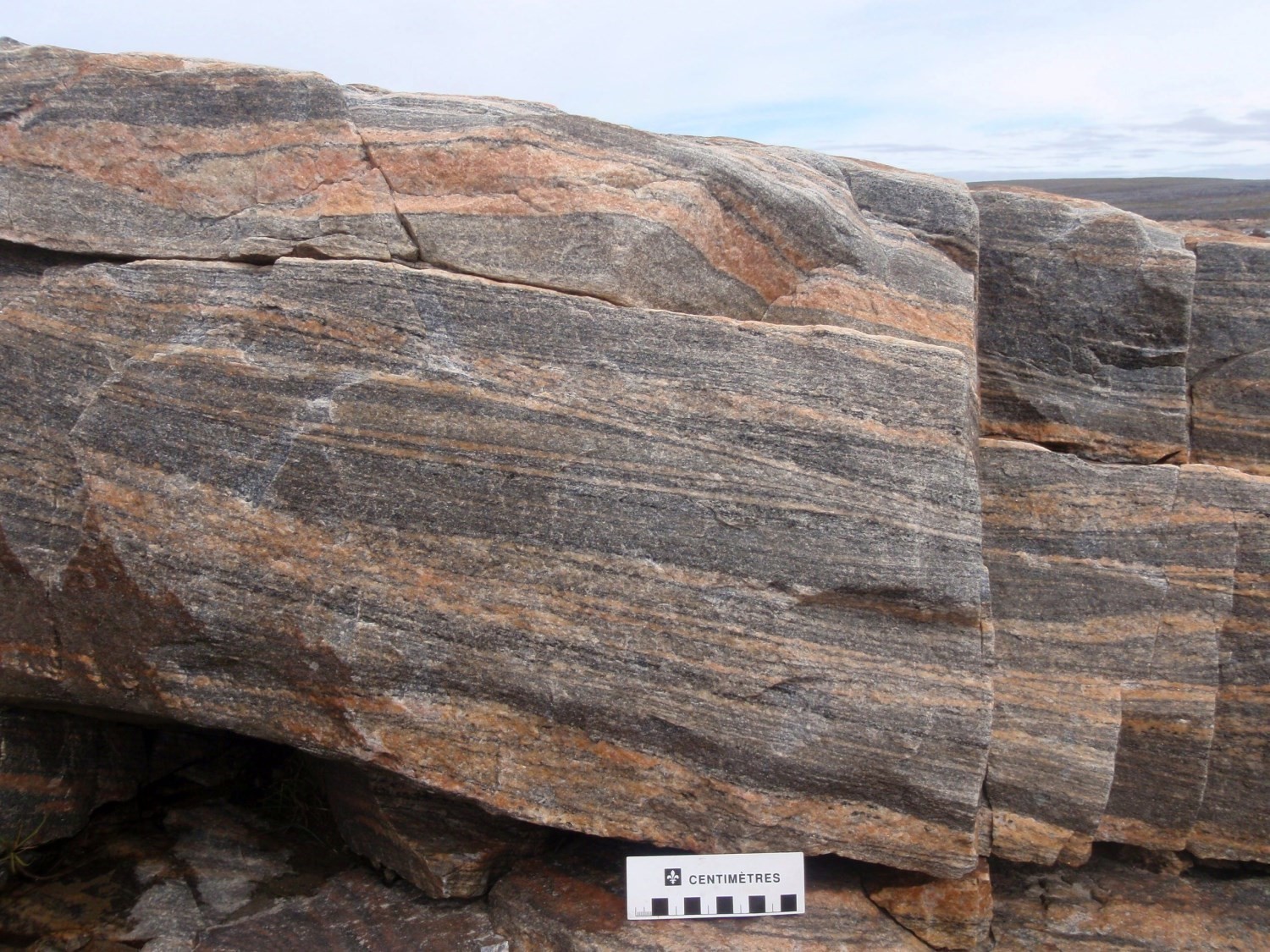
DISCLAIMER: This English version is translated from the original French. In case of any discrepancy, the French version shall prevail.
| Author(s): | Verpaelst et al., 2000 |
| Age: | Archean; Paleoproterozoic |
| Stratotype: | None |
| Type area: | Koroc River area (NTS sheet 24I) |
| Geological province: | Churchill Province |
| Geological subdivision: | Falcoz Lithotectonic Domain |
| Lithology: | Orthogneiss |
| Category: | Lithodemic |
| Rank: | Complex |
| Status: | Formal |
| Use: | Active |
None
Background
The name “Kangiqsualujjuaq Complex” was introduced by Verpaelst et al. (2000) in the Koroc River area (NTS sheet 24I) to designate a tonalitic gneiss unit that is migmatitized to varying degrees. These authors assigned granitic gneiss and granitic intrusive rocks recognized in the same area to the Baudan Complex (now the Baudan Suite). This terminology was not retained by Simard et al. (2013), Lafrance et al. (2015, 2016) and Charette et al. (2016), as it did not allow for regional-scale migmatitic zones to be distinguished from gneissic zones, as Taylor (1979) had done. The migmatitic zones were thus assigned to the Qurlutuq Complex, while tonalitic and granitic gneisses were grouped together in the Ungava Complex. Subsequently, in a synthesis of the southeastern Churchill Province (Lafrance et al., 2018), different lithotectonic domains were identified and it appears that the gneisses observed within these domains are distinct from one another.
In the Falcoz Lithotectonic Domain, all of the tonalitic to granitic grey gneisses were grouped into the Kangiqsualujjuaq Complex by Mathieu et al. (2018). This complex, located east of the Moonbase (ZCmob) and Rivière George (ZCrge) anastomosing shear zones, includes part of the outcrops previously assigned to the Baudan Complex by Verpaelst et al. (2000), namely those of grey granitic gneisses, but excludes migmatitic rocks derived from the melting of these gneisses that were instead assigned to the Fougeraye Complex (Mathieu et al., 2018).
The name Kangiqsualujjuaq comes from the Northern village of the same name located at the mouth of the George River (sheet 24I12). The table below summarizes the correlation between the current and previous units.
| Revised Units and Subunits | Previous Units and Subunits | Reference(s) |
|
Akan1 |
ApPkan1 |
Verpaelst et al., 2000; Mathieu et al., 2018 |
|
ApPung2 (east of ZCrge and ZCmob) |
||
|
Simard et al., 2013; Lafrance et al., 2015 and 2016 |
||
|
Akan1a |
ApPkan1a |
Mathieu et al., 2018 |
|
Akan1b |
ApPung2a (east of ZCrge and ZCmob) |
Simard et al., 2013; Lafrance et al., 2015 and 2016 |
|
ApPkan1b |
Mathieu et al., 2018 |
|
|
Akan2 |
ApPban1 |
Verpaelst et al., 2000 |
|
ApPung4 (east of ZCrge and ZCmob) |
Simard et al., 2013; Lafrance et al., 2015 and 2016 |
|
|
ApPkan2 |
Mathieu et al., 2018 |
|
|
Akan2a |
ApPung4a (east ZCrge and ZCmob) |
Lafrance et al., 2015 and 2016 |
|
Akan3 |
ApPung3 |
Simard et al., 2013; Lafrance et al., 2015 and 2016 |
|
ApPkan3 |
Mathieu et al., 2018 |
|
|
pPfog1 |
ApPkan1 |
Verpaelst et al., 2000 |
Description
The Kangiqsualujjuaq Complex consists of gneiss cut by several Proterozoic granitic phases in the form of multiple intrusions and dykes that are an integral part of the complex. Gneiss also contain decimetric to decametric diorite and gabbro layers and enclaves. The complex consists of three informal units: 1) a tonalitic gneiss unit (Akan1); 2) a granitic gneiss unit (Akan2); and 3) a banded gneiss unit (Akan3).
Kangiqsualujjuaq Complex 1 (Akan1): Tonalitic Orthogneiss
The gneiss composition of unit Akan1 is mostly tonalitic, but locally changes to a quartz diorite. It is medium to light grey and contains between 5 and 25% tonalitic millimetric to centimetric leucocratic bands. Some of these leucocratic bands represent leucosome. The rock is well foliated, fine to medium-grained, and shows partial recrystallization textures and fairly well defined banding. This banding is generally accentuated by the presence of granitic intrusions subconformable to gneissosity. It contains between 8 and 15% ferromagnesian minerals in varying proportions from band to band. These minerals, mainly brown to green biotite with more variable amounts of hornblende, define strong foliation. Gneiss of unit Akan1 may contain up to 5% K-feldspar, interstitial or as exsolution, distributed heterogeneously in the rock. Quartz has undulating extinction and quartzofeldspathic minerals usually show indented rims, indicating dynamic recrystallization. The main accessory minerals are, in order of importance, apatite, zircon, epidote, opaque minerals, sphene, muscovite and allanite. Plagioclase is weakly sericitized in places.
Kangiqsualujjuaq Complex 1a (Akan1a): Fine-Grained Tonalite
In some areas, the Kangiqsualujjuaq Complex contains decametric to kilometric horizons of homogeneous foliated biotite tonalite. These tonalites may represent Archean intrusions that are poorly deformed and weakly affected by Paleoproterozoic migmatization. The presence of small centimetric bands of mobilisate in the tonalite indicates that it has still undergone some degree of partial melting. The tonalite is fine grained, light grey to very light grey, even grained and partially recrystallized. It contains 10-15% biotite and <8% K-feldspar.
Kangiqsualujjuaq Complex 1b (Akan1b): Dioritic Gneiss
The darkest and predominantly dioritic gneissic rocks have been assigned to subunit Akan1b. This unit forms thin klippes less than 2 km wide inside other gneiss units of the Kangiqsualujjuaq Complex. It also occurs as centimetric to metric horizons within the Akan1 tonalitic gneiss. The rock is characterized by alternating millimetric to decimetric bands of diorite, quartz diorite and tonalitic whitish mobilisate (10-25%). Some decimetric layers are more affected by partial melting. Biotite and amphibole are present in greater proportion than in unit Akan1 (15-35%), particularly with hornblende. Accessory minerals observed under the microscope are sphene (<1%), K-feldspar (<2%), epidote, apatite, allanite, opaque minerals and zircon. The rock shows a granoblastic texture, but a slight orientation of all mineral phases can be observed. Hornblende contains quartz and plagioclase inclusions.
Kangiqsualujjuaq Complex 2 (Akan2): Granitic Orthogneiss
In outcrop, granitic gneiss of unit Akan2 is difficult to differentiate from tonalitic gneiss of unit Akan1. It has a light grey colour and contains granitic or granodioritic whitish and pinkish bands that are conformable with gneissosity. Study of thin sections and stains revealed the high percentage of K-feldspar (20-35%) and a lower overall proportion of ferromagnesian minerals (4-12%) in the form of aligned biotite flakes containing zircon inclusions. The gneiss is fine-grained with a foliation defined by biotite alignment and a beginning of preferential orientation of the quartzofeldspathic matrix. K-feldspar grains are evenly distributed in rock and have undergone moderate to high recrystallization, as have plagioclase and quartz grains. Quartz has undulating extinction and myrmekites are present. Accessory minerals are sparse and consist of epidote, allanite, apatite, opaque minerals, zircon, hematite, sphene and muscovite. Weak alterations are observed in places such as plagioclase sericitization and biotite choritization.
Kangiqsualujjuaq Complex 2a (Akan2a): Monzonitic to Monzodioritic Orthogneiss
Locally, there is an occurrence of intermediate potassic gneisses that have been grouped together in subunit Akan2a. In the field, these gneisses have been described as dioritic gneiss more or less migmatized similar to those of subunit Akan1b. However, the study of thin sections and stains revealed the presence of significant amounts of K-feldspar, giving these rocks a composition that varies from monzodiorite to monzonite. The Akan2a rocks contain between 20 and 30% green hornblende and brown biotite, and usually contain bands rich in accessory minerals, the main ones being epidote, sphene, opaque minerals, apatite and allanite.
Kangiqsualujjuaq Complex 3 (Akan3): Banded Orthogneiss
Unit Akan3 is characterized by tonalitic gneiss similar to that of unit Akan1, but contains 25-45% millimetric to centimetric pink granite bands parallel to gneissosity. These bands are fine to medium-grained, partially recrystallized and have undergone the same deformation as the tonalitic portion of the gneiss. The gneiss is partially recrystallized and grain rims are generally indented. Ferromagnesian minerals (5-15%) are dominated by biotite, locally partially chloritized, with some hornblende locally. The main accessory minerals are opaque minerals, epidote, sphene, apatite and zircon.
Unit Akan3 could represent areas where Archean tonalites have been cut by pretectonic granite dykes. Both phases would then have been deformed, folded and paralleled by deformation and metamorphism.
Thickness and Distribution
The Kangiqsualujjuaq Complex covers an area of ~4745 km2 within the Falcoz Lithotectonic Domain. The Akan1 (~1515 km2), Akan2 (~1216 km2) and Akan3 (~1750 km2) units, of similar size, are the most important. They form strips several kilometres wide that are followed by several kilometres in length. The subunits Akan1a (~102 km2), Akan1b (~39 km2), Akan2a (~123 km2) form klippes of much smaller dimensions.
Dating
The dating from several tonalitic gneiss samples (Akan1) resulted in Archean crystallization ages between 3031 Ma and >2767 Ma. This large spread of Archean ages indicates a complex geological evolution.
The Paleoproterozoic ages obtained (1874 to 1845 Ma) correspond to deformation related to the Torngat Orogeny (1885 to 1810 Ma; Charette, 2016; Charette et al., 2021). Crystallization of the migmatitic rocks of the Fougeraye Complex, interpreted as being derived from partial melting of the gneisses of the Kangiqsualujjuaq Complex (Mathieu et al., 2018), is slightly later, around 1835 Ma.
Neoarchean metamorphic ages (~2.6 Ga) suggest that there was also an episode of metamorphism at this time (Lafrance and Vanier, 2022).
| Unit | Sample Number | Isotopic System | Mineral | Crystallization Age (Ma) | (+) | (-) | Metamorphic Age (Ma) | (+) | (-) | Reference(s) |
| Akan1 | 2011-MS-0070A | U-Pb | Zircon | 2861 | 11 | 11 | 1874 | 31 | 31 | Davis et al., 2014 |
| 2013-MP-0090A | U-Pb | Zircon | 2896 | 5 | 5 | 1871 | 15 | 15 | Davis et al., 2018 | |
| 98-SP-4044A1 | U-Pb | Zircon |
2921 |
5 | 5 | 2586 | 14 | 14 | David et al., 2009 | |
| >2865 | 12 | 12 | ||||||||
| 7518 | U-Pb | Zircon | 3031 | 12 | 12 | Isnard et al., 1998 | ||||
| 7514 | U-Pb | Zircon | 2950 | 10 | 10 | |||||
| LC-92-26 | U-Pb | Zircon et monazite | 3019 | 5 | 5 | Scott, 1998 | ||||
| Monazite | 1838 | 2 | 2 | |||||||
| 14CXA-D97B1 | U-Pb | Zircon | 2856 | 8 | 8 | 1845 | 3 | 3 | Corrigan et al., 2018 | |
| Akan1a | 98-SP-4044A2 | U-Pb | Zircon | >2767.1 | 15 | 15 | 1848.5 | 14 | 14 | David et al., 2009 |
| Akan3 | LC-92-32 | U-Pb | Zircon et monazite | 2784 | 9 | 9 | 2666 | Scott, 1998 | ||
| Monazite | 1834 | 2 | 2 |
Stratigraphic Relationship(s)
The Kangiqsualujjuaq Complex is one of the oldest units in the Falcoz Lithotectonic Domain. It is the host rock of the majority of Paleoproterozoic intrusive units; it also forms enclaves in these same units. The Kangiqsualujjuaq Complex gneiss enclaves are particularly prevalent in migmatitic rocks and whitish intrusions of the Fougeraye Complex, which are interpreted as the result of partial melting of the gneisses.
Paleontology
Does not apply.
References
Publications available through SIGÉOM Examine
CHARETTE, B., LAFRANCE, I., MATHIEU, G., 2016. Géologie de la région du lac Jeannin, Québec, Canada. MERN; BG 2015-01, 1 plan.
DAVID, J., MAURICE, C., SIMARD, M., 2009. DATATIONS ISOTOPIQUES EFFECTUEES DANS LE NORD-EST DE LA PROVINCE DU SUPERIEUR – TRAVAUX DE 1998, 1999 ET 2000. MRNF; DV 2008-05, 92 pages.
DAVIS, D. W., LAFRANCE, I., GOUTIER, J., BANDYAYERA, D., TALLA TAKAM, F., GIGON, J., 2018. Datations U-Pb dans les provinces de Churchill et du Supérieur effectuées au JSGL en 2013-2014. MERN; RP 2017-01, 63 pages.
DAVIS, D.W., SIMARD, M., HAMMOUCHE, H., BANDYAYERA, D., GOUTIER, J., PILOTE, P., LECLERC, F., DION, C., 2014. Datations U-Pb effectuées dans les provinces du Supérieur et de Churchill en 2011-2012. MERN, GEOCHRONOLOGICAL LABORATORY; RP 2014-05, 62 pages.
LAFRANCE, I., BANDYAYERA, D., BILODEAU, C., 2015. GEOLOGIE DE LA REGION DU LAC HENRIETTA (SNRC 24H). MERN; RG 2015-01, 62 pages, 1 plan.
LAFRANCE, I., BANDYAYERA, D., CHARETTE, B., BILODEAU, C., DAVID, J., 2016. GEOLOGIE DE LA REGION DU LAC BRISSON (SNRC 24A). MERN; RG 2015-05, 64 pages, 1 plan.
LAFRANCE, I., CHARETTE, B., VANIER, M.-A., 2018. Sud-est de la Province de Churchill, Nunavik, Québec, Canada: synthèse de la géologie. MERN; BG 2018-12.
LAFRANCE, I., CHARETTE, B., VANIER, M.-A., 2018. Southeastern Churchill Province, Nunavik, Québec, Canada: geological synthesis. MERN; BG 2018-12.
LAFRANCE, I., VANIER, M.-A., 2022. Domaine lithotectonique de Falcoz, sud-est de la Province de Churchill, Nunavik, Québec, Canada : synthèse de la géologie. MERN; BG 2022-01, 2 plans.
MATHIEU, G., LAFRANCE, I., VANIER, M.-A., 2018. Géologie de la région de pointe Le Droit, Province de Nain et sud-est de la Province de Churchill, Nunavik, Québec, Canada. MERN; BG 2018-07, 4 plans.
MATHIEU, G., LAFRANCE, I., VANIER, M.-A., 2018. Geology of the Pointe Le Droit region, southeastern Churchill Province, Nunavik, Québec, Canada. MERN; BG 2018-07, 4 plans.
SIMARD, M., LAFRANCE, I., HAMMOUCHE, H., LEGOUIX, C., 2013. GEOLOGIE DE LA REGION DE KUUJJUAQ ET DE LA BAIE D’UNGAVA (SNRC 24J, 24K). MRN; RG 2013-04, 62 pages, 1 plan.
VERPAELST, P., BRISEBOIS, D., PERREAULT, S., SHARMA, K. N. M., DAVID, J., 2000. Géologie de la région de la rivière Koroc et d’une partie de la région de Hébron, 24I et 14L. MRN; RG 99-08, 62 pages, 10 plans.
Other publications
CHARETTE, B., 2016. Long-lived Anatexis in the Exhumed Middle Crust from the Torngat Orogen and Eastern Core Zone: Constraints from Geochronology, Petrochronology, and Phase Equilibria Modelling. University of Waterloo; thèse de maîtrise, 389 pages. uwspace.uwaterloo.ca/handle/10012/10453
CHARETTE, B., GODET, A., GUILMETTE, C., DAVIS, D.W., VERVOORT, J., KENDALL, B., LAFRANCE, I., BANDYAYERA, D., YAKYMCHUK, C., 2021. Long-lived anatexis in the exhumed middle crust of the Torngat Orogen: Constraints from phase equilibria modelling and garnet, zircon, and monazite geochronology. Lithos; volume 388-389. doi.org/10.1016/j.lithos.2021.106022
ISNARD, H., PARENT, M., BARDOUX, M., DAVID, J., GARIÉPY, C., STEVENSON, R.K. 1998. U-Pb, Sm-Nd and Pb-Pb isotope geochemistry of the high-grade gneiss assemblages along the southern shore of Ungava Bay. In: Wardle R.J., Hall, J. (Eds.), Eastern Canadian Shield Onshore–Offshore (ECSOOT), Transect Meeting, 1998. The University of British Columbia; Lithoprobe Secretariat, Report 68, pages 67-77.
SCOTT, D.J., 1998. U–Pb ages of Archean crust in the southeast arm of the Rae Province, southeastern Ungava Bay, Quebec. Geological Survey of Canada; Paper 1998-F, pages 41-45.
TAYLOR, F.C., 1979. Reconnaissance geology of a part of the Precambrian Shield, northeastern Quebec, northern Labrador and northwest Territories. Geological Survey of Canada; Memoir 393, 99 pages, 19 maps. doi.org/10.4095/124930
Suggested Citation
Ministère de l’Énergie et des Ressources naturelles (MERN). Kangiqsualujjuaq Complex. Quebec Stratigraphic Lexicon. https://gq.mines.gouv.qc.ca/lexique-stratigraphique/province-de-churchill/complexe-de-kangiqsualujjuaq_en [accessed on Day Month Year].
Contributors
|
First publication |
Isabelle Lafrance, P. Geo., M.Sc. isabelle.lafrance@mern.gouv.qc.ca (redaction) Mehdi A. Guemache, P. Geo., Ph.D. (coordination); Claude Dion, Eng., M.Sc. (critical review); Simon Auclair, P. Geo., M.Sc. (editing); Céline Dupuis, P. Geo., Ph.D. (English version); Yan Carette (HTML editing). |
|
Revision(s) |
Isabelle Lafrance, P. Geo., M.Sc. (redaction; 7 October 2022) Mehdi A. Guemache, P. Geo., Ph.D. (coordination); Marc-Antoine Vanier, Eng., M.Sc. (critical review); Simon Auclair, P. Geo., M.Sc. (editing); Dominique Richard, GIT, Ph.D. (English version); André Tremblay (HTML editing). |


